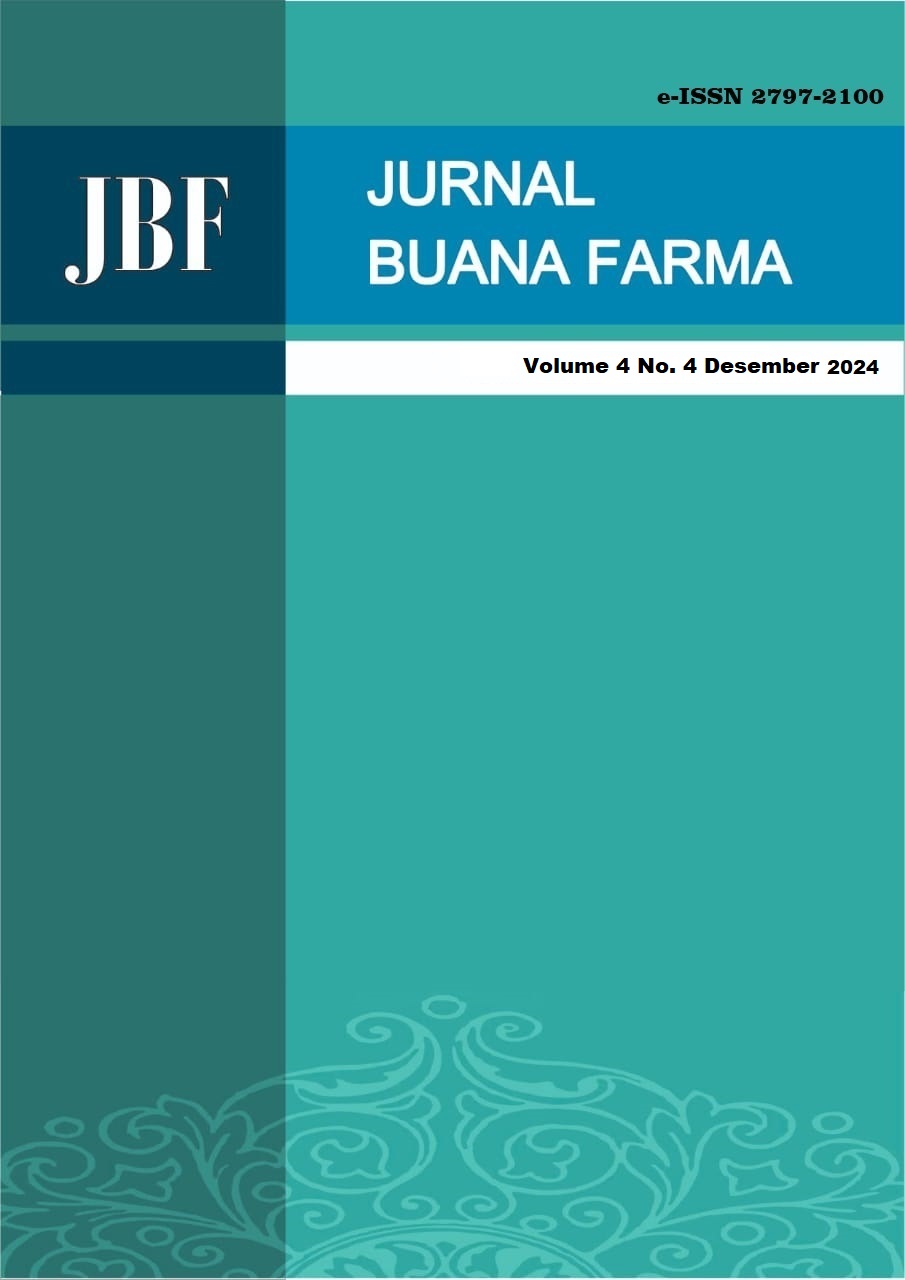PENGARUH RESVERATROL TERHADAP JALUR PERMEABILITAS BARU SEBAGAI TARGET KERJA ANTIMALARIA
Abstrak
Plasmodium merupakan parasit penyebab penyakit malaria, ditularkan kepada manusia melalui gigitan nyamuk Anopheles betina. Plasmodium yang menginfeksi sel darah merah akan menyebabkan pembentukan jalur permeabilitas baru atau new permeability pathway (NPP) pada membran sel darah merah. Hal ini menyebabkan membran sel darah merah menjadi lebih permeabel, sehingga memungkinkan berbagai nutrisi yang dibutuhkan parasit masuk ke dalam sel darah merah. Resveratrol merupakan senyawa polifenol yang dilaporkan memiliki aktivitas antimalaria melalui pengambatan pertumbuhan Plasmodium berghei. Penelitian ini bertujuan untuk mengevaluasi aktivitas resveratrol dalam menghambat NPP. Penelitian dimulai dengan pembuatan suspensi darah mencit terinfeksi dan tidak terinfeksi kemudian ditambahkan sediaan uji dan diinduksi menggunakan sorbitol kemudian diukur tingkat hemolisis menggunakan spektrofotometer UV-visible. Kelompok uji terdiri dari kelompok normal, kontrol dan berbagai konsentrasi resveratrol yaitu 1,25; 2,5; 5; 10 dan 20 μM. Parameter pengamatan pada penelitian ini adalah persen hambatan hemolisis. Berdasarkan hasil penelitian persentase hambatan hemolisis makin meningkat seiring dengan kenaikan konsentrasi resveratrol. Nilai IC50 dari pengujian aktivitas hambatan NPP resveratrol adalah 1,025 μM. Kesimpulan dari penelitian ini adalah resveratrol dapat menghambat NPP pada eritrosit yang terinfeksi Plasmodium berghei.
Referensi
Bouyer, G., Barbieri, D., Dupuy, F., Marteau, A., Sissoko, A., N’Dri, M. E., Neveu, G., Bedault, L., Khodabux, N., Roman, D., Houzé, S., Siciliano, G., Alano, P., Martins, R. M., Lopez-Rubio, J. J., Clain, J., Duval, R., Egée, S., & Lavazec, C. (2020). Plasmodium falciparum sexual parasites regulate infected erythrocyte permeability. Communications Biology, 3(726), 1–10. https://doi.org/10.1038/s42003-020-01454-7
CDC. (2024). Malaria. https://www.cdc.gov/dpdx/malaria/index.html
Chabib, L., Muhtadi, W. K., Rizki, M. I., Rahman, R. A., Suhendri, M. R., & Hidayat, A. (2018). Potential medicinal plants for improve the immune system from Borneo Island and the prospect to be developed as nanomedicine. MATEC Web of Conferences, 154. https://doi.org/10.1051/matecconf/201815404006
Counihan, N. A., Modak, J. K., & de Koning-Ward, T. F. (2021). How Malaria Parasites Acquire Nutrients From Their Host. Frontiers in Cell and Developmental Biology, 9. https://doi.org/10.3389/fcell.2021.649184
Deore, N. B., & Bakliwal, A. A. (2019). Optimization and Validation of Resveratrol Using Analytical UV Method Development. Journal of Pharmaceutical Sciences and Research, 11(5), 2024–2027.
Dickerman, B. K., Elsworth, B., Cobbold, S. A., Nie, C. Q., McConville, M. J., Crabb, B. S., & Gilson, P. R. (2016). Identification of inhibitors that dually target the new permeability pathway and dihydroorotate dehydrogenase in the blood stage of Plasmodium falciparum. Scientific Reports, 6(3752). https://doi.org/10.1038/srep37502
Go, M. L., Liu, M., Wilairat, P., Rosenthal, P. J., Saliba, K. J., & Kirk, K. (2004). Antiplasmodial chalcones inhibit sorbitol-induced hemolysis of Plasmodium falciparum-infected erythrocytes. Antimicrobial Agents and Chemotherapy, 48(9), 3241–3245. https://doi.org/10.1128/AAC.48.9.3241-3245.2004
Handari, B. D., Ramadhani, R. A., Chukwu, C. W., Khoshnaw, S. H. A., & Aldila, D. (2022). An Optimal Control Model to Understand the Potential Impact of the New Vaccine and Transmission-Blocking Drugs for Malaria: A Case Study in Papua and West Papua, Indonesia. Vaccines, 10(1174). https://doi.org/10.3390/vaccines10081174
Hermanto, F., Ahsanul Haq, F., & Refiani, A. (2023). Resveratrol Reduce the Severity of Anemia and Thrombocytopenia in Plasmodium berghei ANKA-Infected Mice. Jurnal Farmasi Dan Ilmu Kefarmasian Indonesia, 10(3), 266–271. https://doi.org/10.20473/jfiki.v10i22023.266-271
Hermanto, F., Nur Anisa, I., Wahyuningsih, S., Alatas, F., Lucky Rachmawan, R., Ahsanul Haq, F., & Adhary, F. (2022). Aktivitas Antiplasmodium dan Pengaruh Resveratrol terhadap Indeks Organ Mencit yang Terinfeksi Plasmodium berghei ANKA. Pharmaceutical Journal of Indonesia, 19(01), 28–39.
Hermanto, F., Sari Dewi, P., Ahsanul Haq, F., & Melsandy, N. (2023). Potensi Resveratrol dalam Mengurangi Keparahan Malaria Serebral Pada Mencit yang Terinfeksi Plasmodium berghei ANKA. Medical Sains : Jurnal Ilmiah Kefarmasian, 8(4), 1481–1488.
Latifah, N., Subarnas, A., & Chaerunisaa, A. Y. (2020). Antimalaria Medicine and Its Mechanism : A Review. Majalah Farmasetika, 5(1), 39–48. https://doi.org/10.24198/mfarmasetika.v5i1.25927
MalariaGEN Plasmodium falciparum Community Project. (2016). Genomic epidemiology of artemisinin resistant malaria. https://doi.org/10.7554/eLife.08714.001
Merckx, A., Nivez, M. P., Bouyer, G., Alano, P., Langsley, G., Deitsch, K., Thomas, S., Doerig, C., & Egée, S. (2008). Plasmodium falciparum regulatory subunit of cAMP-dependent PKA and anion channel conductance. PLoS Pathogens, 4(2), e19. https://doi.org/10.1371/journal.ppat.0040019
National Center for Biotechnology Information. (2024, July 16). PubChem Compound Summary for CID 445154, Resveratrol. Https://Pubchem.Ncbi.Nlm.Nih.Gov/Compound/Resveratrol.
Oliveira, A. B., Fâni Dolabela, M., Braga, F. C., Jácome, R. L. R. P., Varotti, F. P., & Póvoa, M. M. (2009). Plant-derived antimalarial agents: new leads and efficient phythomedicines. Part I. Alkaloids. Annals of the Brazilian Academy of Sciences, 81(4), 715–740. www.scielo.br/aabc
Shaito, A., Posadino, A. M., Younes, N., Hasan, H., Halabi, S., Alhababi, D., Al-Mohannadi, A., Abdel-Rahman, W. M., Eid, A. H., Nasrallah, G. K., & Pintus, G. (2020). Potential adverse effects of resveratrol: A literature review. In International Journal of Molecular Sciences (Vol. 21, Issue 2084). MDPI AG. https://doi.org/10.3390/ijms21062084
Staines, H. M., Ellory, J. C., & Chibale, K. (2004). Furosemide analogues as potent inhibitors of the new permeability pathways of Plasmodium falciparum-infected human erythrocytes. Molecular and Biochemical Parasitology, 133(2), 315–318. https://doi.org/10.1016/j.molbiopara.2003.10.009
Staines, H. M., Powell, T., Thomas, S. L. Y., & Ellory, J. C. (2005). The New Permeability Pathways: Targets and Selective Routes for the Development of New Antimalarial Agents. Combinatorial Chemistry & High Throughput Screening, 8, 81–88.
WHO. (2023). World malaria report 2022. https://www.wipo.int/amc/en/mediation/













